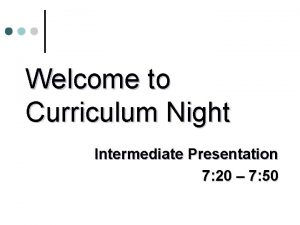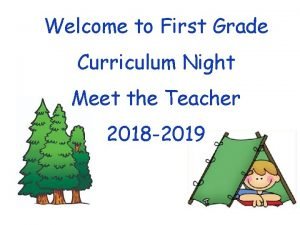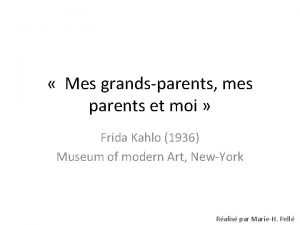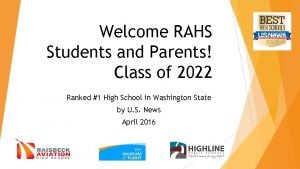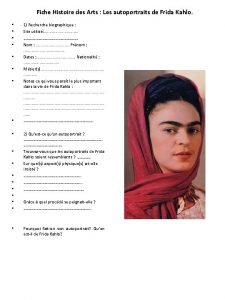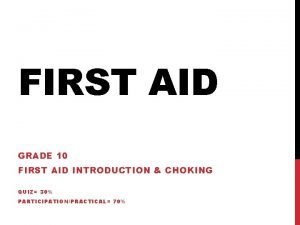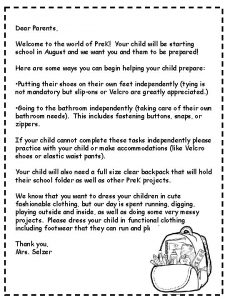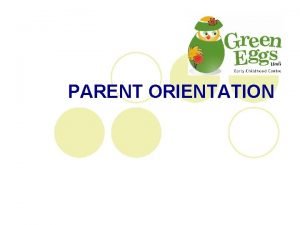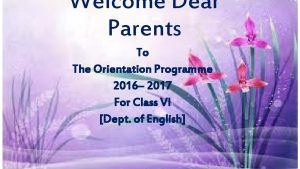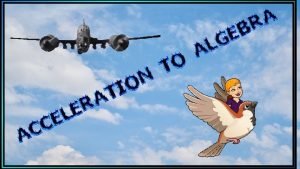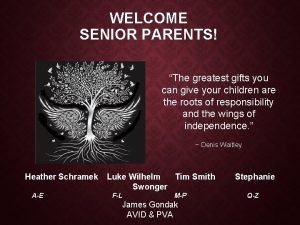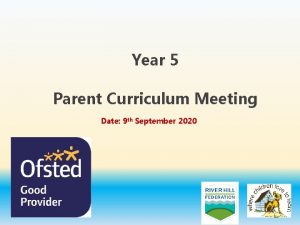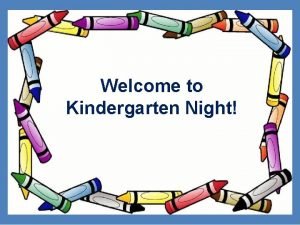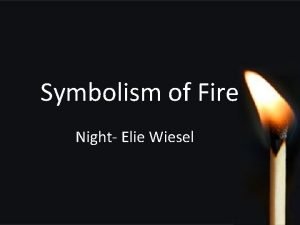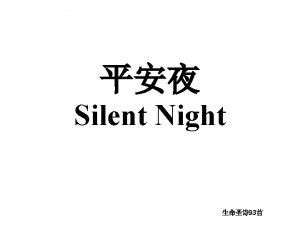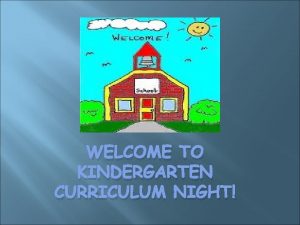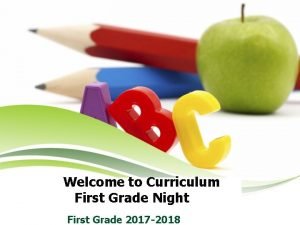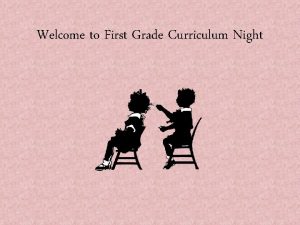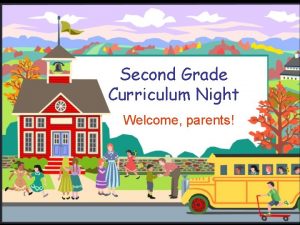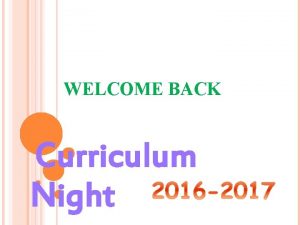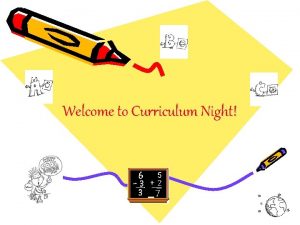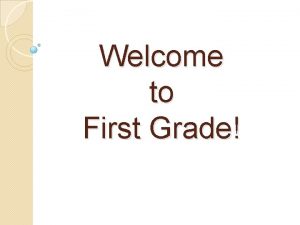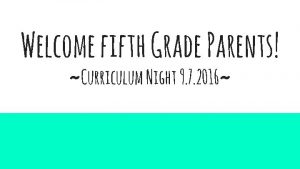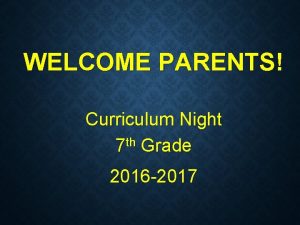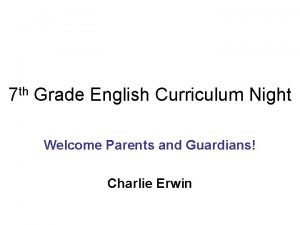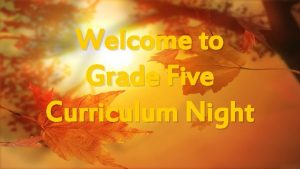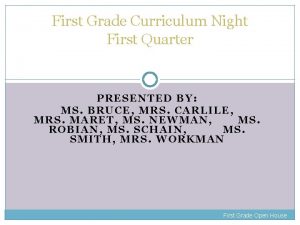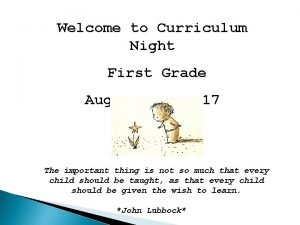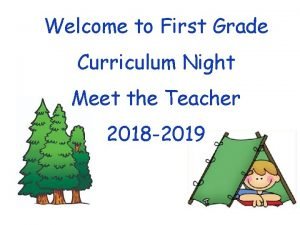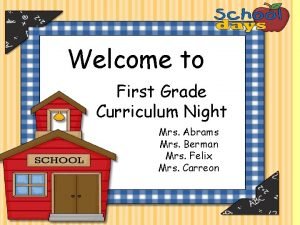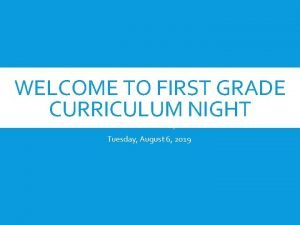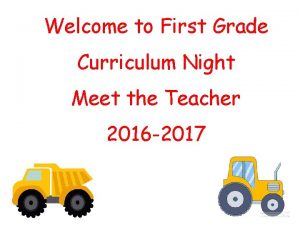WELCOME PARENTS TO THE FIRST GRADE CURRICULUM NIGHT



















- Slides: 19

**WELCOME PARENTS TO THE FIRST GRADE CURRICULUM NIGHT

READING IN FIRST GRADE *The two main components of the first grade reading program-Guided Reading (Small group literacy activities) -Whole Group Literacy Activities *With the new Common Core Standards, your child will be exposed to and read more Nonfiction text.

GUIDED READING Our guided reading groups take place daily. Generally a group contains from 4 to 6 students. Each individual classroom contains a wide range of reading levels. We use the students’ most current Running Record Level to create guided reading groups. The Running Record also gives us insight into the student’s level of fluency. Fluency involves the child’s ability to read with speed, accuracy, and proper expression. The students will practice fluency throughout the first grade year. Next year fluency will be factored into the overall reading grade.

WHY IS GUIDED READING SO IMPORTANT? In guided reading groups, the students interact with text on their reading level. In the small group setting, we are able to better meet the needs of each individual student. Also in the small group setting, we are better able to monitor the strengths and needs of the students.

WHOLE GROUP LITERACY ACTIVITIES Word Study Activities (Practice with our sight words, word family activities, etc. ) Fiction/Non-fiction Read Alouds Phonemic Awareness (Pre-reading skills) Phonics-We use the Wilson Fundations Program. Fluency Practice Vocabulary

WHAT CAN YOU DO TO HELP AT HOME? Make sure that your child is reading each night. After reading, make sure your child can tell you about what he/she has read or heard. Ask questions about the characters, the setting, the problem, and the solution. (*SPLASH) Read aloud to your child. Regardless of your child’s reading level, he/she still needs to hear you read. This is a great way to model fluent reading while exposing your child to more challenging text. (*SPLASH) Practice the first grade high frequency words. Be sure to check over your child’s homework with your child, make necessary corrections, and initial the homework contract.

FIRST GRADE WRITING STANDARDS

TYPES OF WRITING In the Common Core Standards there are three main types: 1. Opinion 2. Informative/Explanatory 3. Narrative (Personal and Imaginative) We will administer and score a minimum of four formal writing samples this year. ***A key feature of the new writing standards is the continual and seamless integration of the writing into reading and content area work (writing across the curriculum-science, math, social studies. )

EMERGENT ** STUDENT ESTABLISHES A RELATIONSHIP BETWEEN PICTURE & PRINT. ** WRITES 1 -2 SENTENCES FOCUSED ON A TOPIC. **ADDS DETAILS TO DRAWING. **USES TEMPORARY SPELLING. ** SPELLS NAMES AND FAMILIAR WORDS CORRECTLY.

EARLY DEVELOPING ** WRITES A FEW SHORT, PATTERNED, REPETITIVE SENTENCES FOCUSED ON A FAMILIAR TOPIC. ** RELATES DRAWINGS & WRITING TO CREATE A MORE MEANINGFUL TEXT. ** USES SPACES CONSISTENTLY. ****SPELLS SIMPLE WORDS, USES TEMPORARY SPELLING AND SPELLS SOME HIGH FREQUENCY WORDS CORRECTLY. ** USES CAPITAL LETTERS FOR NAMES AND BEGINNING OF SENTENCES. ** USES PERIODS CORRECTLY.

** WRITES SEVERAL SENTENCES ABOUT A TOPIC. ** WRITES IN COMPLETE SENTENCES. ** WRITES IN LOGICAL SEQUENCE. ** USES DRAWINGS TO ENHANCE MEANING. ** USES LIST-LIKE DETAILS/DESCRIPTIVE LANGUAGE. ** BEGINS TO WRITE WITH A SENSE OF AUDIENCE. ** SPELLS MANY HIGH FREQUENCY WORDS CORRECTLY. ** USES TEMPORARY SPELLING THAT CAN BE READ BY OTHERS AND MOVES MORE TOWARDS CONVENTIONAL SPELLING. ** USES CAPITAL LETTERS AND END PUNCTUATION CORRECTLY AND CONSISTENTLY.

MATH CURRICULUM In 2009 ABSS adopted Math Expressions as a Core Program. It is a comprehensive K-5 mathematics curriculum that offers new ways to teach and learn mathematics.

COMMON CORE STATE STANDARDS FOR MATHEMATICS CONSIST OF 4 DOMAINS: Operations and Algebraic Thinking Number and Operations in Base Ten Measurement and Data Geometry

MATH EXPRESSIONS IS ORGANIZED AROUND 5 CRUCIAL CLASSROOM STRUCTURES: *QUICK PRACTICE *MATH TALK *BUILDING CONCEPTS *HELPING COMMUNITY *STUDENT LEADERS

ACCOUNTABILITY Math Expressions utilizes formal and informal assessments to inform and guide student instruction. Quick quizzes are included within each unit and Unit tests are given at the conclusion of each unit. In addition all first graders will be given a Mid Year and End of Grade Math test from the state of NC.

MATH EXPRESSIONS LESSONS OFFER DIFFERENTIATION FOR ALL LEARNERS: INTERVENTION, ON LEVEL, AND CHALLENGE TO SUPPORT CLASSROOM NEEDS. TECHNOLOGY RESOURCES VISIT WWW. EDUPLACE. COM/MX 2 T MATH EXPRESSIONS WEBSITE AND FIND FAMILY, TEACHER, AND STUDENT MATERIALS, ACTIVITIES, GAMES, AND MORE.

COMMON CORE STATE STANDARDS FOR SCIENCE *Solid Earth Materials *Patterns of Earth/Moon/Sun systems *Force and Motion *Living Organisms

COMMON CORE STATE STANDARDS FOR SOCIAL STUDIES *Civics and Governance *History and Culture *Economics and Financial Literacy *Geography and Environmental Literacy

THANK YOU FOR COMING!! WE APPRECIATE YOUR SUPPORT!
 Welcome to curriculum night
Welcome to curriculum night Welcome to curriculum night
Welcome to curriculum night Mes grands parents mes parents et moi
Mes grands parents mes parents et moi Parents parents
Parents parents Histoire des arts frida kahlo
Histoire des arts frida kahlo Ice cream soda jump rope song
Ice cream soda jump rope song Three ps in first aid
Three ps in first aid Welcome to the parents world
Welcome to the parents world How to welcome parents in orientation
How to welcome parents in orientation Welcome dear parents
Welcome dear parents Welcome parents and guardians
Welcome parents and guardians Senior night gifts from parents
Senior night gifts from parents Curriculum meeting for parents
Curriculum meeting for parents Welcome welcome this is our christmas story
Welcome welcome this is our christmas story Welcome to kindergarten night
Welcome to kindergarten night Symbolism in night
Symbolism in night Silent night holy night all is calm all is bright
Silent night holy night all is calm all is bright Curriculum night prayer
Curriculum night prayer Engage new york kindergarten
Engage new york kindergarten What is kindergarten curriculum night
What is kindergarten curriculum night
